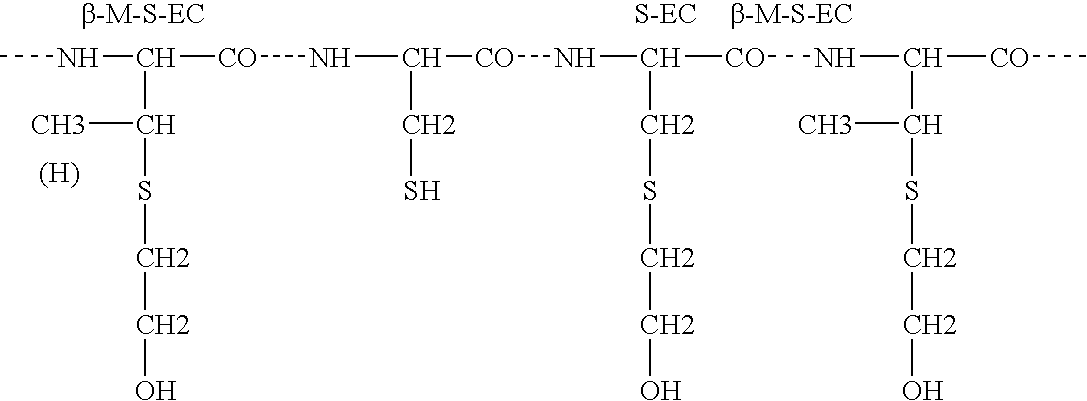Antimicrobial polypeptide, nucleic acid, and methods of use
a technology of antimicrobial polypeptides and nucleic acids, applied in the field of new drugs, can solve the problems of rapid loss of all biosynthetic processes, death of target cells, and difficult isolation of mutacins from liquid medium,
- Summary
- Abstract
- Description
- Claims
- Application Information
AI Technical Summary
Benefits of technology
Problems solved by technology
Method used
Image
Examples
example 1
Purification of a Lantibiotic
[0056]A lantibiotic was purified from Streptococcus mutans JH1140 using the following procedure:
[0057]Four liter batches of Todd-Hewitt broth (THB; Difco) containing 0.5% LE agarose (SeaKem) were sterilized and poured into 90 mm petri plates. The plates were dried overnight at 37° C. A pure culture of JH1140 on a brain-heart infusion starter plate was used to inoculate 3 ml of THB and the cell suspension was vortexed for 10 sec. About 0.3 ml of the cell suspension was spread on the surface of a BHI agar plate and incubated overnight at 37° C. in a candle jar.
[0058]A 10-pronged inoculator was ethanol-flame sterilized and used to inoculate JH1140 from the spread plate into evenly spaced stabs in the plates prepared as described above. The plates were incubated in candle jars at 37° C. for 72 hours. The agar was entirely scraped from the plates and placed into centrifuge bottles. The bottles were stored overnight at −20° C.
[0059]The bottles were then centri...
example 2
Bioassay of Lantibiotic Activity
[0063]Antimicrobial activity of the lantibiotic was determined by the following procedure: 5 ml of Todd Hewitt broth (THB) were inoculated with S. rattus strain BHT-2 (resistant to 1 mg / ml streptomycin); and grown overnight standing at 37° C. 0.02 ml of fractions to be tested for lantibiotic activity were serially 2-fold diluted in distilled water in microtiter wells. Top agar was prepared containing BHI broth, 0.75% agar, 1 mg / ml streptomycin, and 1:10,000 diluted overnight S. rattus BHT-2 culture from above at 42° C.; 0.2 ml was pipetted into each microtiter well. After 5 min. at room temperature to allow agar to set, the plate was incubated at 37° C. overnight.
[0064]The minimal inhibitory concentration (MIC) was determined as the reciprocal of the highest dilution of the test fraction which inhibited growth of S. rattus BHT-2 by visual inspection.
example 3
Spectrum of activity of the Lantibiotic
[0065]Single colonies of a strain producing mutacin 1140 were stab inoculated into brain THB and incubated overnight in candle jars at 37° C. Three drops of an overnight THB culture of the indicator strain were mixed with 3 ml of molten top agar and poured evenly over the surface of the plate. After an additional 24 hours of incubation, clear zones surrounding the test strain were measured.
[0066]Representative strains of various bacteria were tested for their sensitivity to the inhibitory activity of the mutacin 1140 produced by a JH1140 strain by using a overlay technique. In addition to S. mutans, most Gram positive organisms were found to be sensitive, including Streptococcus mitts, Streptococcus pyogenes, Staphylococcus aureus, and Actinomyces species. The inhibitory factor inhibited 124 of 125 S. mutans strains tested. Gram-negative bacteria were mostly resistant to inhibition by mutacin 1140. The following table summarizes the spectrum of...
PUM
| Property | Measurement | Unit |
|---|---|---|
| temperature | aaaaa | aaaaa |
| diameter | aaaaa | aaaaa |
| diameter | aaaaa | aaaaa |
Abstract
Description
Claims
Application Information
 Login to View More
Login to View More - R&D
- Intellectual Property
- Life Sciences
- Materials
- Tech Scout
- Unparalleled Data Quality
- Higher Quality Content
- 60% Fewer Hallucinations
Browse by: Latest US Patents, China's latest patents, Technical Efficacy Thesaurus, Application Domain, Technology Topic, Popular Technical Reports.
© 2025 PatSnap. All rights reserved.Legal|Privacy policy|Modern Slavery Act Transparency Statement|Sitemap|About US| Contact US: help@patsnap.com



